As of May 2023, there are 43 ramen restaurants in Japan that carry the “Ramen Jiro” sign (check the latest number here…), and one of the 42 restaurants (excluding the main restaurant) that is highly rated among” Jiroians (Jiro ramen lovers)” is the Ramen Jiro Kanda Jimbo-cho restaurant, which opened in November 2004 on the north side of Jimbo-cho subway station and later moved to its current location by Jimbocho Kagetsu in 2017, where it continues to operate. Despite being a Jiro-style ramen restaurant, it is so popular not only among Jiroians but also among ramen lovers in general that it was selected as one of the 100 best ramen restaurants in Ramen TOKYO in the 2019 by Tabelog.
This Kanda Jimbocho store is famous as the birthplace of the mysterious word “allways,” which is only understood between Jiro-kei Ramen restaurants and Jiroians nationwide. Anything…
(The Kanda Jimbocho store) serves allways with a high level of passable quality.
Is it just me, or does this comment itself seem somewhat like a curse?
Putting that incantation aside, I visited Ramen Jiro Kanda Jimbocho, which is supposed to “always serve high-level ramen”, one weekday afternoon after 1:00 pm. I was prepared for this before I arrived, but the wait was not half as long as I expected…
Even if the line is long, be smart about waiting… How to get in line at Ramen Jiro Kanda Jimbocho Branch and the rules for ordering.
When I arrived at Ramen Jiro Kanda Jimbocho on this day, the line looked like this…
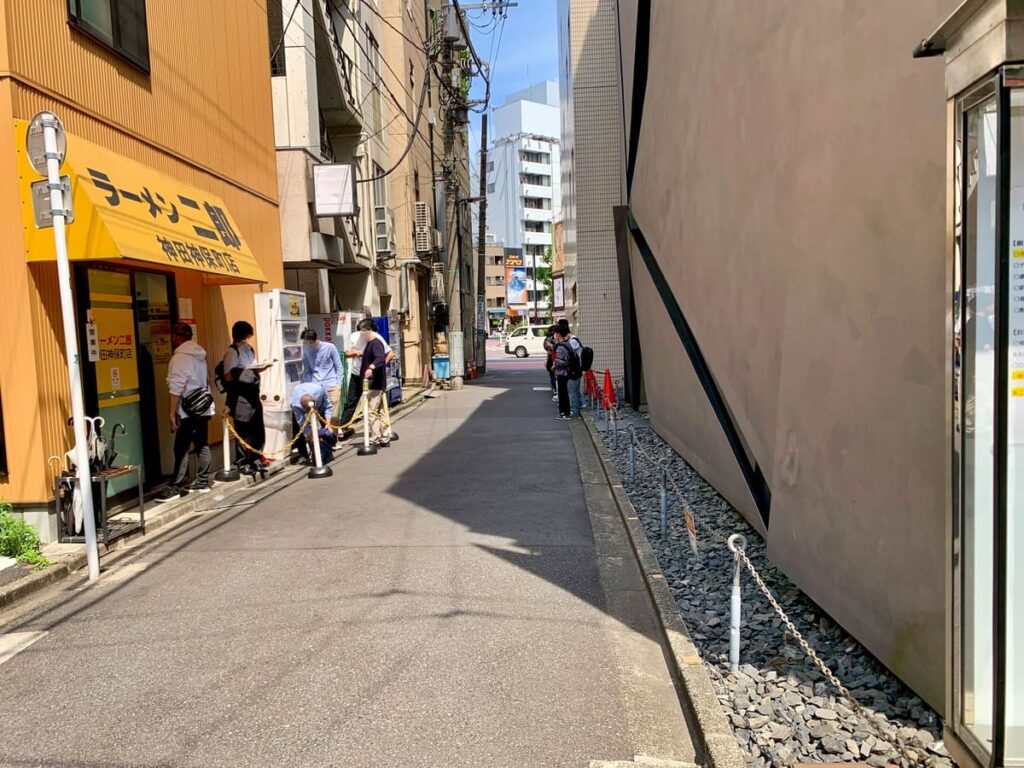
There were two crowds, one on the side of the restaurant and the other on the other side of the narrow alley. There were just about 20 customers ahead of us at that time, and the wait time from the beginning of the line to entering the restaurant was 1 hour and 20 minutes.
Now, Ramen Jiro Kanda Jimbocho has its own rules when it comes to waiting in line. Especially when visiting the restaurant for the first time, it is recommended that you keep this rule in mind or have it readily available on your phone so that you do not bother other customers or passersby.
First, take a look at the image below…
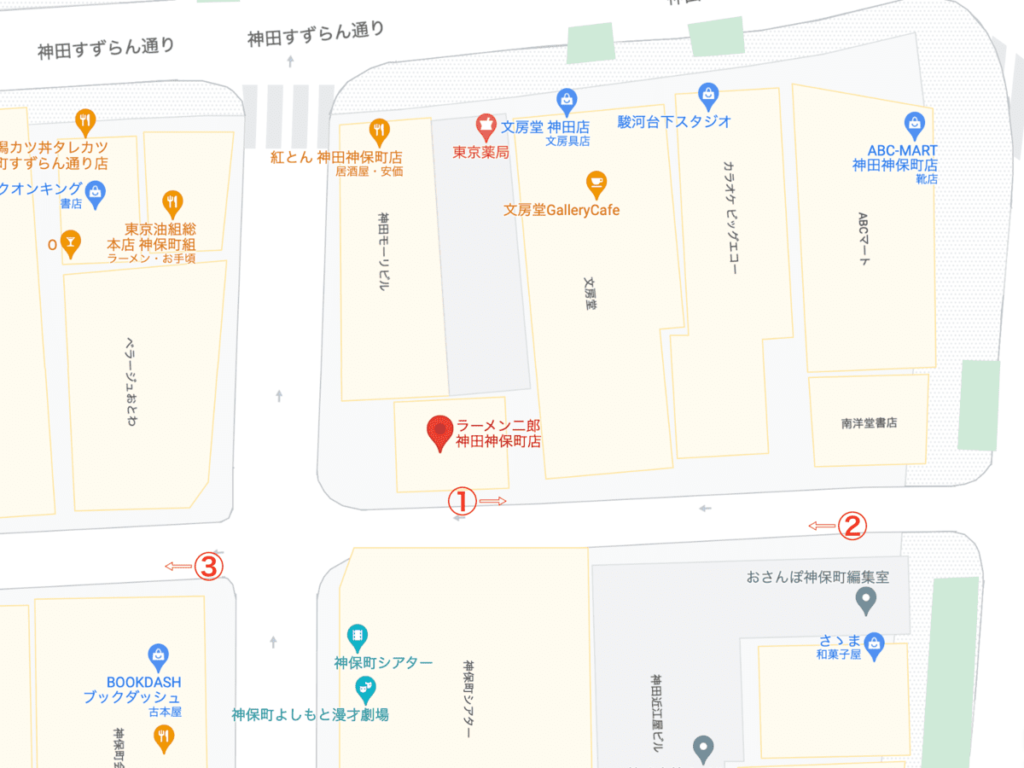
As you can see, the queue for Ramen Jiro Kanda Jimbocho is divided into three areas. I will describe each of these as Zone 1 through Zone 3.
The first 11 people in line for Zone 1 are the first 11 people in line, which is a bit excessive, but this is because the restaurant has only 11 seats (counter seats only). In other words, these 11 people are the next people who can enter the restaurant.
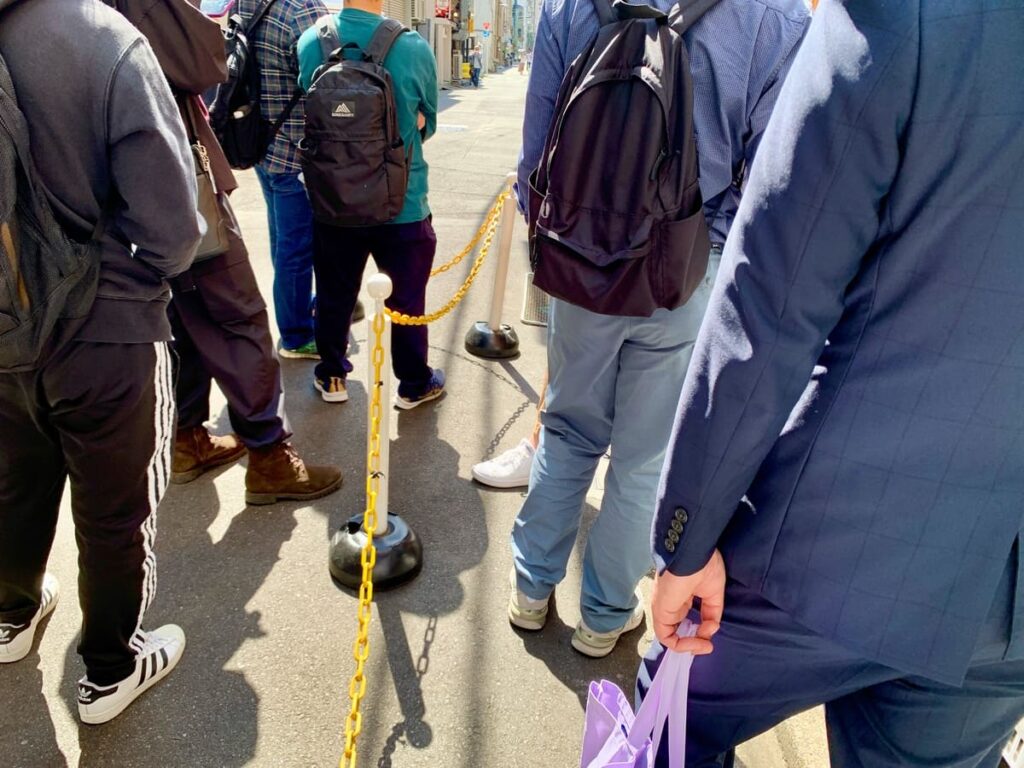
However, you will actually be divided into two lines of six plus five people, and the line of six and the line of five people will enter the restaurant on a semi-switching basis, alternating between the two lines. When it is your turn to enter the restaurant, the waiter will ask you how much noodles you want, and you should verbally tell him or her the amount of noodles you want (normal, large, small, or half). It is only after you are actually guided into the restaurant that you purchase a meal ticket. Don’t forget to buy a meal ticket for the amount of ramen noodles you verbally stated.
Oh, yes, one important note. Ramen Jiro Kanda Jimbocho is actually famous for having a particularly large amount of noodles among all the Jiro-style ramen restaurants in Japan. The actual amount of noodles is…
- Half a bowl of noodles: approx. 200-250g
- Less noodles, about 300g
- Normal, about 400g
- Large, about 500g
This is just a rough estimate, but it’s about right. This is about one more than you would order at other Jiro or Jiro-inspired restaurants. Be careful not to order the same amount as usual and leave out any leftovers.
Those who did not make it to Zone 1 will have to wait in line for Zone 2 and Zone 3. All zones are marked with red cones, so start lining up there…
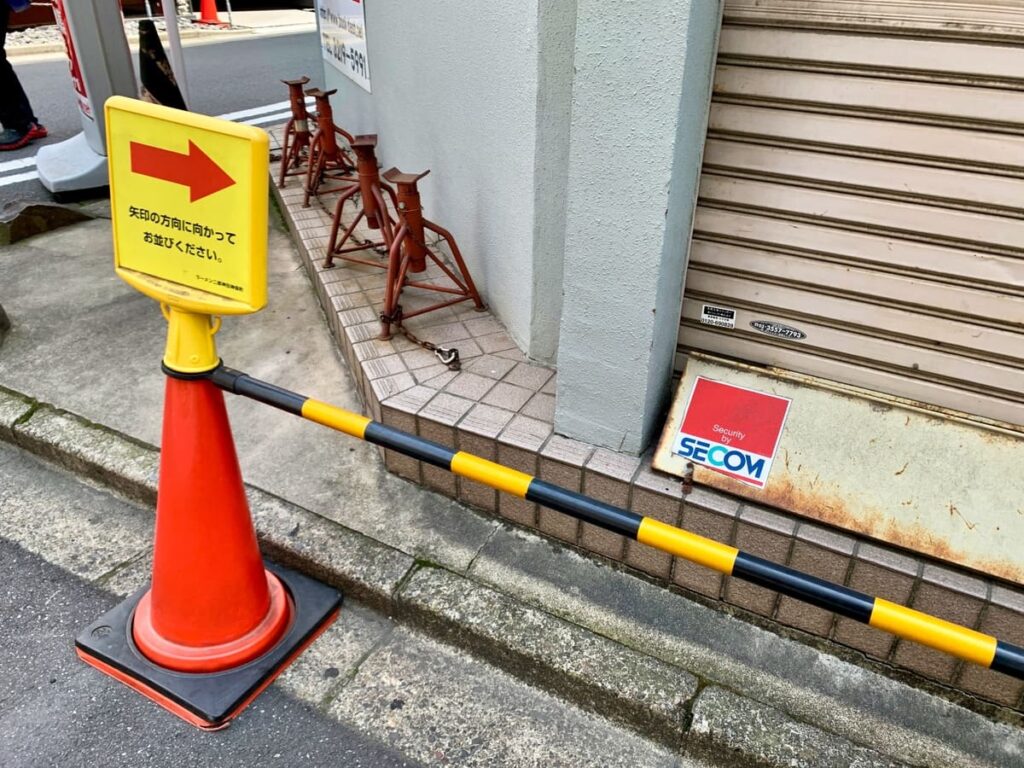
By the way, even if there is an opening in Zone 1, do not move by yourself. A staff member will come out of the store to guide you, and you will remain there until he or she does so. One last thing: please be moderate in your queuing. Ramen Jiro Kanda Jimbocho is equipped with security cameras for monitoring…
Small Pork ramen: Ramen Jiro Kanda Jimbocho’s popular menu is just too destructive!
Let me introduce you to the small pork (less noodles) I ordered at Ramen Jiro Kanda Jimbocho Branch this time. This time, I called for “garlic and abura mashi,” but when I saw what actually arrived on the table…
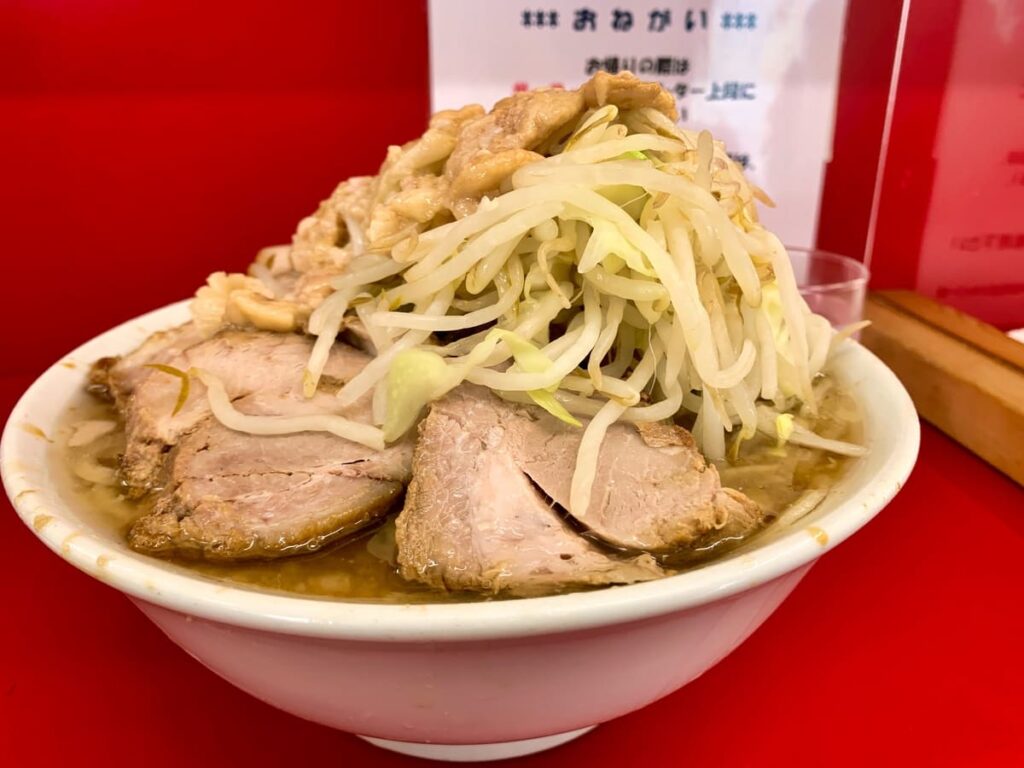
Isn’t the amount of vegetables amazing? This is the default amount. It is not as much as a “vegetable mashi mashi (“Mashi mashi” means double increased amount),” but it is definitely as much as a “vegetable mashi” at other restaurants. I wonder what you would get if you order “Vegetable Mashi Mashi”? I am sure that it would have a far greater impact than the Vegetable Mashimashi I ordered at Rekishi wo Kizame Nakamozu…
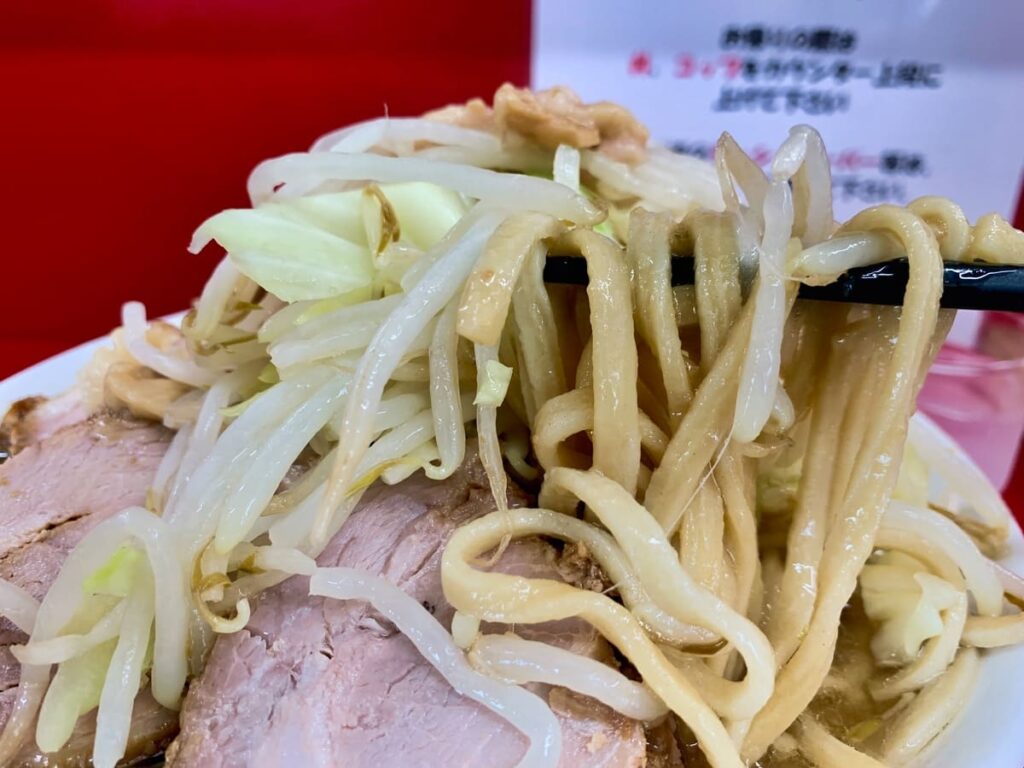
But that aside, let’s start with the actual meal! When I tried to pull the noodles out of the bowl, I felt a tremendous weight in my right hand through the chopsticks… This is clearly a larger portion than the small ramen (300g noodles) at Ramen Jiro Mita Head Store, even though I ordered “less noodles”. This time, I ordered more pork, and I’m glad I didn’t get carried away and order a “large” ramen. The noodles are slightly hard-boiled, so you can enjoy the familiar “chewy” texture of Jiro-style ramen to the fullest.
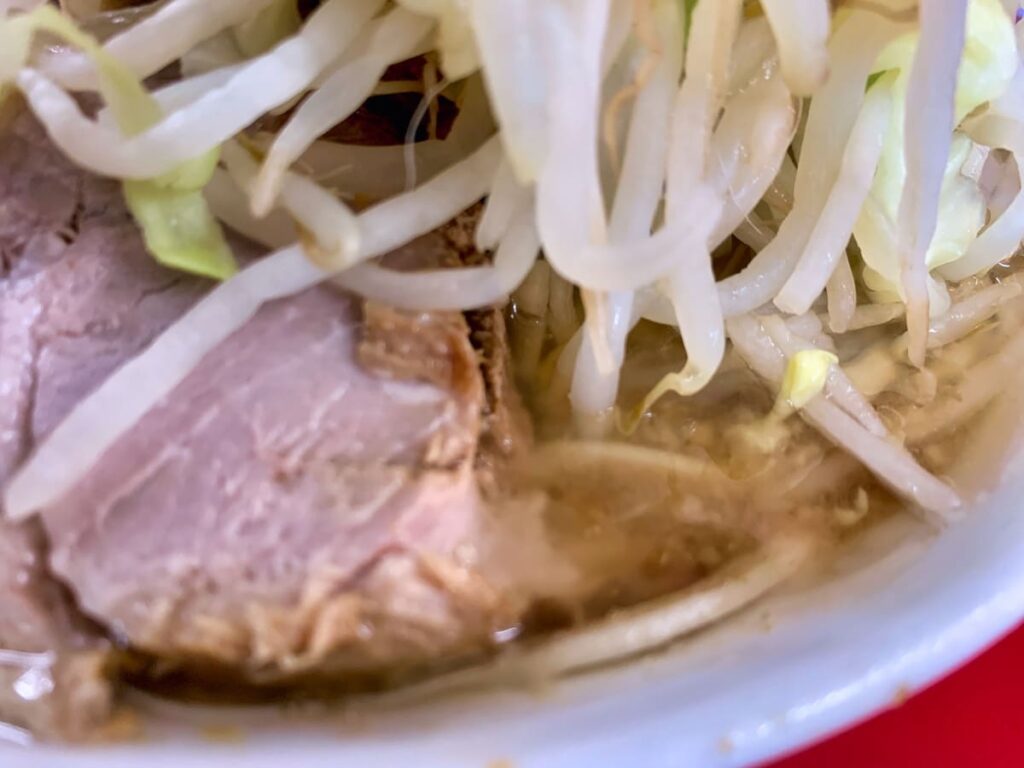
The soup on the other hand is like this. It is a non-emulsified soup with a sharp soy sauce flavor. However, it is not overly strong like the one at the Kyoto branch of Ramen Jiro, and is close to the perfect concentration for my personal taste. The pork flavor is as rich as the soy sauce, and the soy sauce and pork are in perfect harmony without being sharp. If this were not a Jiro restaurant, I might finish the soup.
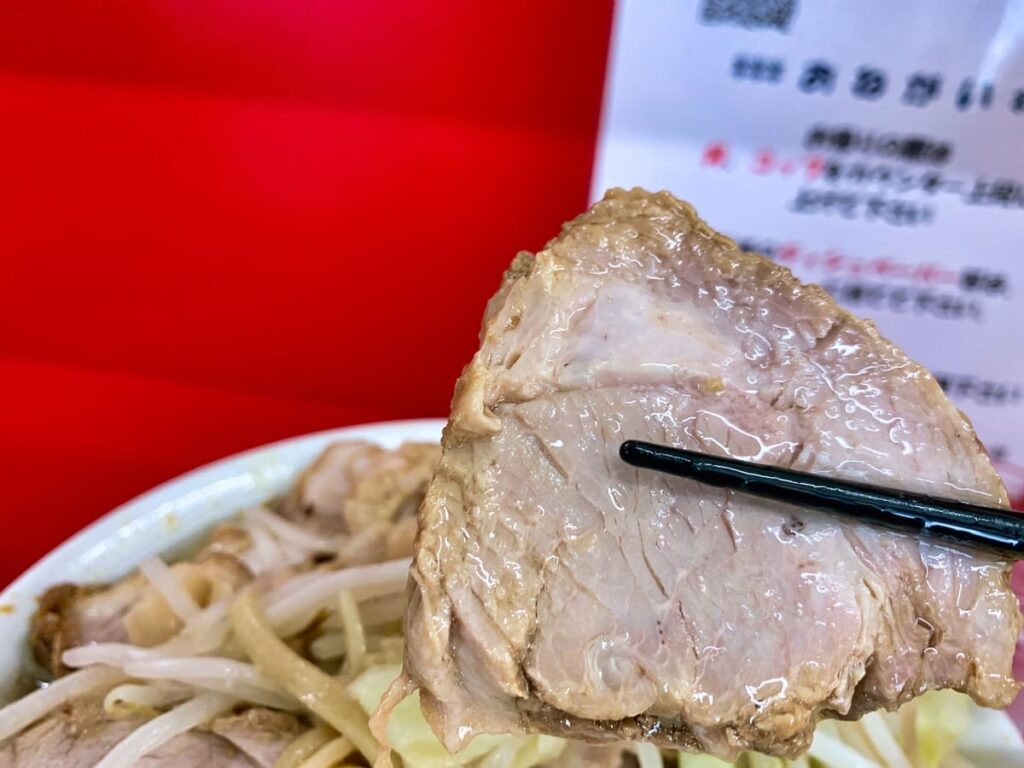
And there were a total of five pieces of chashu pork, which were added for an extra 100 yen from the standard ramen. Familiar to Jiro, they are no longer chashu but pork blocks. Not only is it full of meatiness, but contrary to its appearance, it is soft, so you can munch on it without much jaw fatigue. To be able to eat this much meat for only 100 yen extra is, to put it mildly, a god of cost performance.
I don’t know if the small pork at Ramen Jiro Kanda Jimbocho like this is “allways” or not, but I can confirm that the level is “high” as the word of mouth at the beginning of this article says. Above all, to be able to eat such a destructive and voluminous ramen with only one 1,000 yen bill (and get the change back)… for students and businessmen in the vicinity, it must be a presence that makes sweat run like a waterfall from their eyes.
If I had to point out a drawback, it would be the slow turnover of customers. Compared to other ramen stores, the turnover speed is obviously slow. The manager seems to work at his own pace and in a relaxed manner, so you don’t feel the pressure that is unique to Jiro-style ramen. It’s probably a good thing that I don’t have to slurp my ramen in a hurry…
Ramen Jiro Kanda Jimbocho’s complete menu (prices include tax)
- Ramen 850 yen
- Small pork 950 yen
- Large 950 yen
- Large Pork 1050 yen
- Green onion 100 yen
- 5 quail eggs 100 yen
- Shredded ginger 100 yen
- Raw egg 50 yen
- Soup-free sauce (to-go only) 1,200 yen
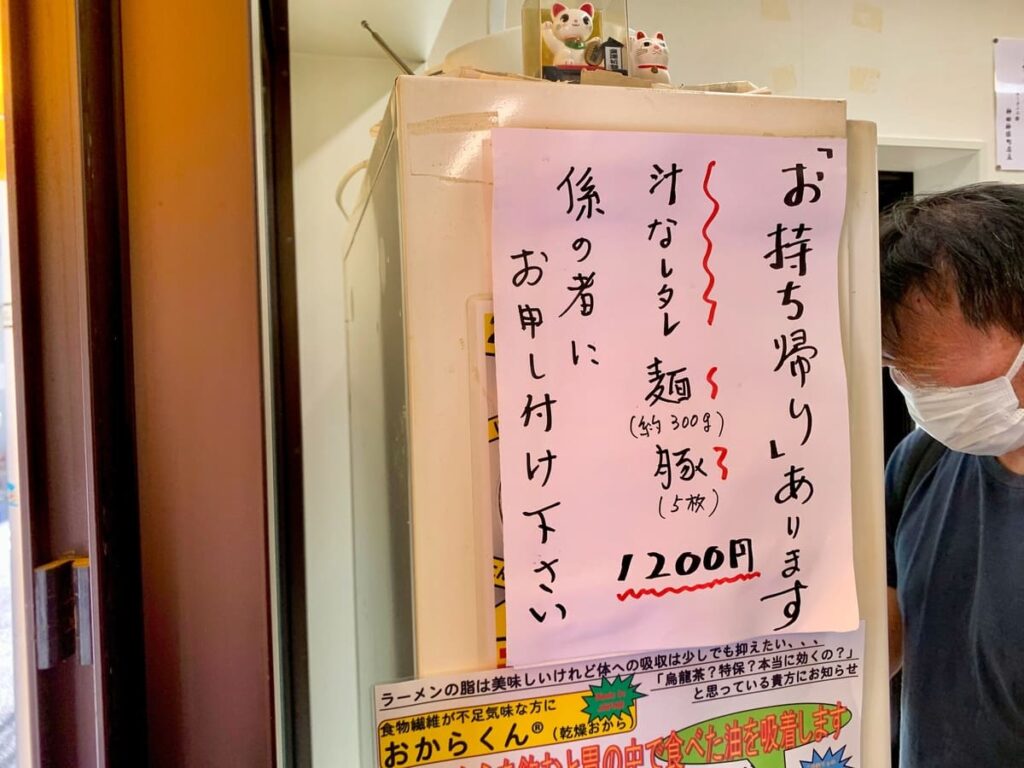
Apparently there is a mail magazine… Access to Ramen Jiro Kanda Jimbocho is a 3-minute walk from Exit A7 of Jimbocho Station on the Toei Shinjuku Line (Toei Mita Line and Tokyo Metro Hanzomon Line), the nearest station
Ramen Jiro Kanda Jimbocho Branch also seems to operate a mail magazine, which is unusual for a ramen restaurant. If you sign up for this newsletter, you can get the latest information on events, store closures, etc. for free. It seems that it is still being distributed properly, so there is no harm in registering if you are a heavy user. You can register from the link I posted above, if you like.
Now, here are the details of the store. You can see the store data here…
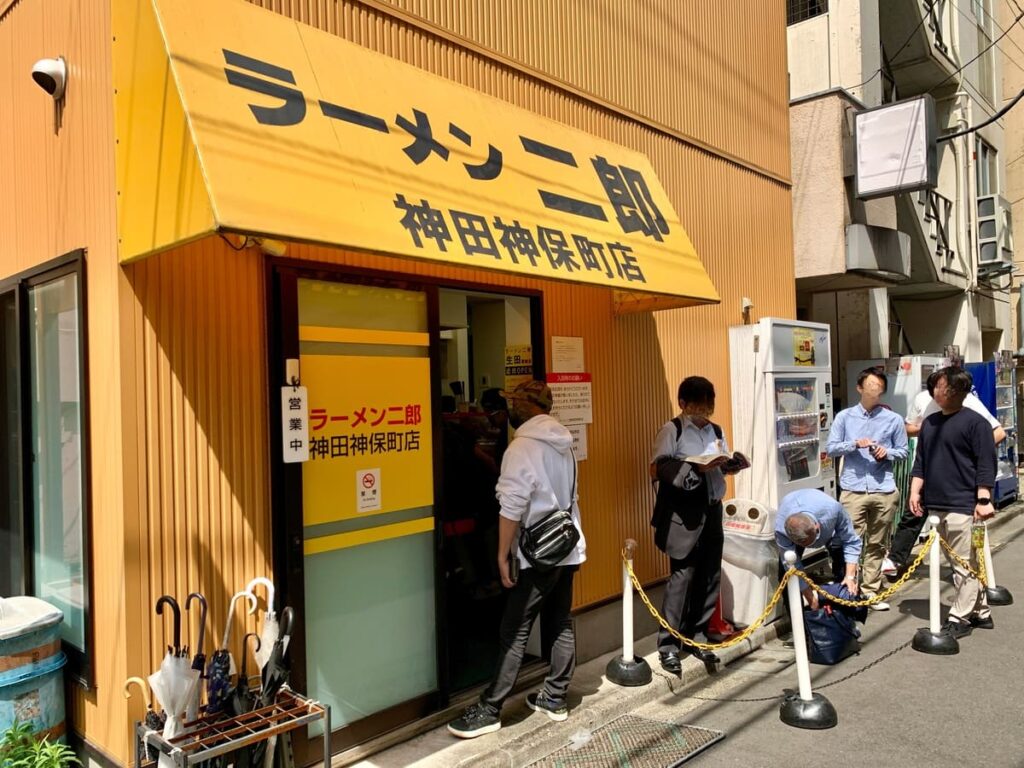
Ramen Jiro Kanda Jimbocho Branch Out of 5
.Address: 1-21-4 Kanda Jimbocho, Chiyoda-ku, Tokyo 101-0051
Phone number: Not open to the public
Business hours: 11:00-17:30 (closes when sold out → will be announced on the store’s Twitter)
Closed: Sundays and national holidays (other temporary closures are possible)
Parking:Not available
Credit card payment:Not accepted (meal ticket system)
From Ochanomizu Station on the JR Chuo Line, it is only an 8-minute walk.
In order to be objective in my evaluation of the restaurant, I will also introduce some reviews from other blogs…
It turns brown when the noodles are returned to give the soup a sense of unity.
Yes, the soup is non-emulsified, but the pork extract is still present, and the Kaneshi soy sauce gives the soup a punch.
The soup used to be heavy with a lot of back fat of the hanpen type, but it is now a fine type, somewhere between heavy and light, and yes, it is delicious!
Two large pieces of pork.
It is a winner…….fibrous yet soft workmanship.
The yasai was boiled and fried, so it had a nice crunchy texture and I was able to replenish the yasai to the fullest!
ユー坊のラーメン日記と酒とB級グルメ
ラーメン二郎 神田神保町店/小ラーメン@東京都千代田区(神田神保町)The soup is a bit slightly emulsified, with a layer of nice smelling liquid abra.
It also smells of pork and has a strong flavor.
The FZ is exquisite and the soup is just like you would expect from Jimbocho.
Next, the noodles.
The noodles are soft and chewy.
They have a nice aroma of wheat and absorb the flavor of the soup!
However, the amount of noodles is also Jimbocho. It is so delicious that the noodles go on, but they don’t decrease.
Finally, the pork.
There are three pigs and some fine ones.
The texture is soft and tender. It is juicy with some fat.
The pork is well-seasoned and has a strong umami flavor!
The first topping is green onion. It is cut into large pieces and has a crunchy texture.
The leeks have a strong flavor and a refreshing feeling.
ほのぼの◆ジログ
ラーメン二郎@神田神保町店P.S. If you are looking for delicious ramen in Tokyo, please stop by this article…

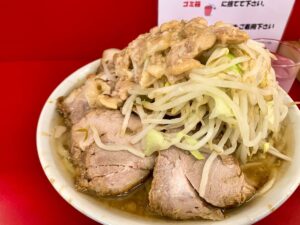
 Zento Yo Yo
Zento Yo Yo
Leave a Reply